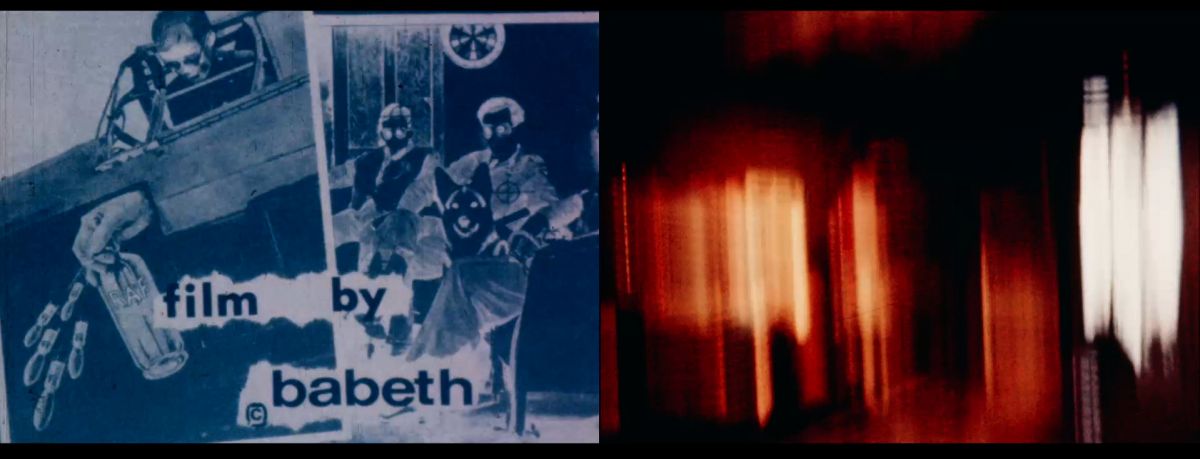Chance versus Causality: The New Realists
↳ Babeth Mondini-VanLoo

NL, US 1979, 00:35:00
In Chance Versus Causality: The New Realists, filmmaker Babeth Mondini-VanLoo uses the principle of chance to visualise the European art movement Nouveau Réalisme, which emerged in Milan in the 1960s. The film follows one of its main protagonists, Daniel Spoerri, and his work in San Francisco, Paris, and Cologne. Working with Expanded Cinema, often using multiple screens, Babeth also explored chance as a guiding principle for this film, to evoke crucial impulses and contribute important elements to the spirit of the art movement she is trying to capture. The film contextualises the work of Spoerri by creating random coincidences in the juxtaposition of the images, where mistakes and errors become essential steps in the filmmaking process. She aims for a discovery to unravel the different approaches of Pop Art in the United States and Nouveau Realism in Europe. Intrigued by the use of the object in the art of this movement, the filmmaker gives a broad perspective on how chance emerged here after Surrealism and Dada, and follows in the footsteps of that tradition by incorporating found film footage, honouring Spoerri’s use of the found object in his Tableaux Pièges. The interplay of the two screens is beyond control and predictability to trigger our reactivation of the senses, an important theme in Babeth’s art. The principle of chance further leads to the inclusion of works by other members, such as Christo’s Running Fence in California and Jean Tinguely and Niki de Saint Phalle, who are encountered in part 2 at the Musée Beaubourg in Paris, and the filming of Spoerri at his atelier in an old watermill. The private and the public intermingle, as do the informative and the associative in the double-screen juxtaposition. Part 3 documents Musée Sentimental, where Spoerri exhibits the history of Cologne with artists such as Polke, Wewerka, Bazon Brock, rock musicians and many others who gather for his Eat Art event.
The soundtrack was composed by the post punk band Cabaret Voltaire and recorded in 1979. The track Chance Versus Causality was improvised in a similar way to what the band call their live “ambient sets.” It was recorded live by the original Cabaret Voltaire line-up — Richard H. Kirk, Stephen Mallinder, and Chris Watson — at their Western Works studio, with no limiting instructions from the film director. Part of the soundtrack was released on the B-side of “Silent Command 7.” Live and improvised, yet cohesive with a touch of mischief and warmth, this single piece of music is an evocative snapshot of this era of Cabaret Voltaire with the release of Nag, Nag, Nag and ahead of the Voice of America album, which has strong ties to this soundtrack release through the vocal samples and overall sound.
Before the performance we will screen Andy Warhol’s Unfinished Symphony (NL, 1975, 26’, 16mm) by Babeth Mondini-VanLoo. Babeth’s 16mm debut in the US humorously explores the legacy of Andy Warhol, reflecting on the plastic society of the 1960s through Warhol’s interview style and American archetypes, exploring human identity and alienation. Featuring a stunning performance by George Kuchar, the film uses Warhol’s words in a drama filmed at the San Francisco Art Institute’s Walter/McBean Gallery. It critiques the alienation of the 1970s, contrasted with the warmth of the 1960s, through visually rich, melodramatic scenes expressing yearning and desire, underscored by a deep concern for human connection.
SPECTRAL is a four-year collaborative project between six artist-run film labs with a DIY philosophy that focuses on the expansive possibilities of live cinema and analogue projection. The project includes artist residencies, workshops, the creation of hybrid film equipment, screenings, and expanded events.
- Programm Programme: Chance versus Causality: The New Realists